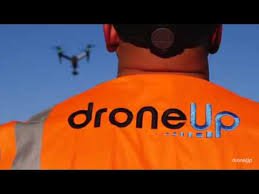A DroneUp patent, published today, demonstrates just why the company is leading the pack of large service providers.
Three years ago, Tom Walker and his partners had a great idea. What if there were an automated system that allowed a central agency like DroneUp to enter a job into a pilot network database; figure out which pilots were appropriate, available, and local; and then send them the job offer via an app? Then, when the right pilot for the job accepted, the requestor could send more details on the job directly to them. It was a great idea designed to make the whole system of a drone services company work well for both the central agency and the pilots. Investors loved it, pilots raved about it.
Then they had an even better idea. What if we patent it?
That patent – Multiplexed Communications for Coordination of Piloted Aerial Drones Enlisted to a Common Mission – has now been granted. The patent issued today by the PTO relates to a web-based platform for managing and communicating with drone pilots and assigning them missions. Once you get through the verbiage about “multiplexed communications” and “multiple piloted assets” the concept is (relatively) simple: use a mobile app to assign drone missions to a pilot. It’s the same concept that has allowed Walker, who founded DroneUp in 2016 and is listed as an inventor on the patent, to build a network of licensed, vetted and trained pilots; keep them working; and make it pay.
DroneUp’s contracts for state and government agencies have exploded: in the private sector, they’re everywhere – and business is only getting better during COVID, as industry utilizes drone tech to operate efficiently with fewer resources. At a time when some drone services companies are contracting, DroneUp is expanding with new acquisitions and new plans for growth. The publication of the patent leaves a lot of options open for DroneUp. Known for being a common sense voice in the drone industry, Walker is all about doing what you can, right now; whatever the conditions. The DroneUp patented system has flexibility: it works for drone service providers, or easily translates to large enterprise drone platforms. They could sell it or license it, or just decide to keep it as a competitive advantage – the patent could spell trouble for other service providers using similar systems. DroneUp has not issued an announcement about the patent or their plans.
In a conversation with DRONELIFE several months ago about DroneUp’s last mile drone delivery testing, Tom Walker summed up DroneUp’s growth and position right now with typical understatement: “It’s an interesting time for the drone industry,” he said. “Interesting times.”
Miriam McNabb is the Editor-in-Chief of DRONELIFE and CEO of JobForDrones, a professional drone services marketplace, and a fascinated observer of the emerging drone industry and the regulatory environment for drones. Miriam has penned over 3,000 articles focused on the commercial drone space and is an international speaker and recognized figure in the industry. Miriam has a degree from the University of Chicago and over 20 years of experience in high tech sales and marketing for new technologies.
For drone industry consulting or writing, Email Miriam.
TWITTER:@spaldingbarker
Subscribe to DroneLife here.
https://dronelife.com/2020/08/11/droneup-patent/
 Unmanned Aerial Vehicle The latest drone news
Unmanned Aerial Vehicle The latest drone news





